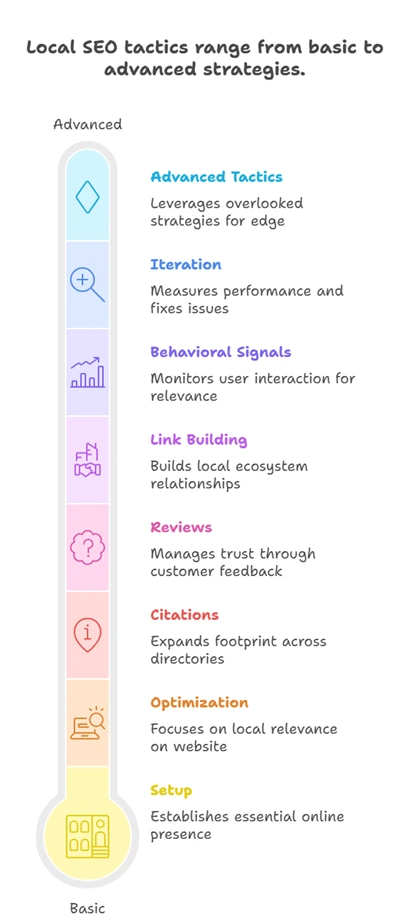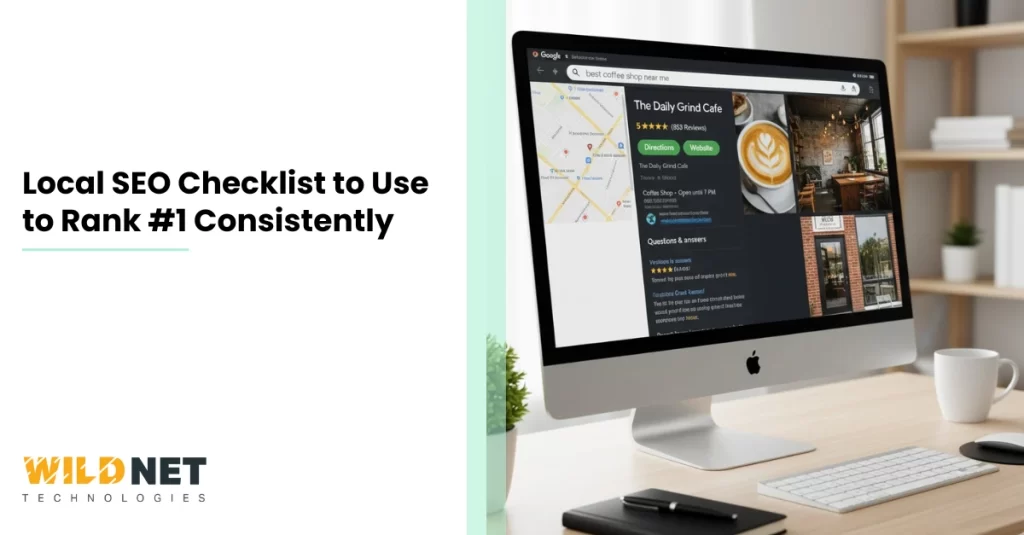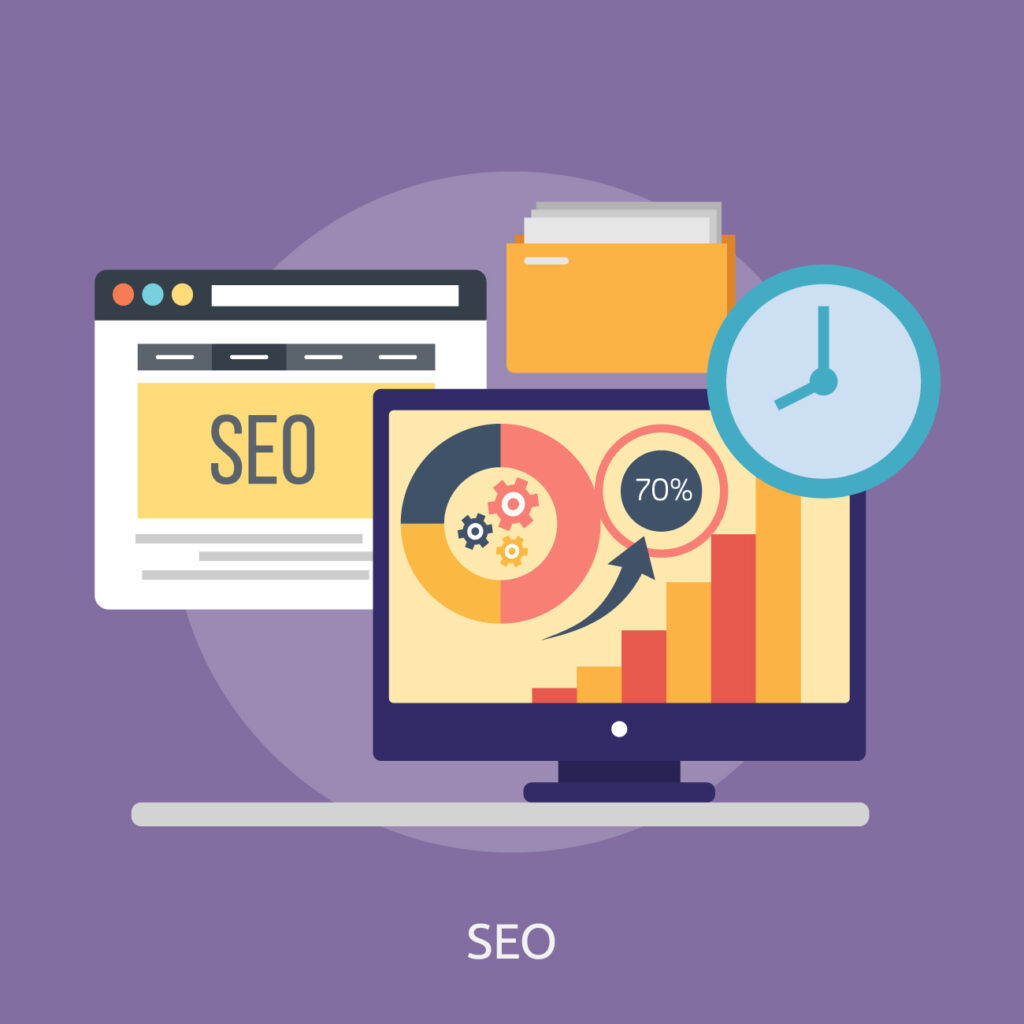If you run a local business, be it a café, a dentist clinic, a gym, or a small retail shop, you probably already know that being discovered locally is everything.
But just “having a website” isn’t enough. You want people near you to find you when they search for services you provide. That’s where Local SEO comes in.
Local SEO helps your business show up in map results, local packs, and neighborhood searches. In fact, “near me” searches have surged over the years.
According to BrightLocal’s studies, many consumers search online before visiting a physical store.
So what’s the recipe for local search success? That’s where your “Local SEO Checklist” comes into play.
In this blog, we, as the digital marketing services provider, will walk you step by step through a checklist you can swear by because it’s practical, actionable, and grounded in what top SEO experts recommend.
How to Use This “Local SEO Checklist”
Before we dive in, a quick tip:
- Think of this checklist as your playbook. You don’t necessarily have to do every item in one go, but over time you should aim to cover them all.
- Some items are foundational (you can’t skip them), and others are “bonus boosters” that give you an edge.
- Always track progress along the way. SEO is a long game. (More on that in the metrics section below.)

Image 1.1 Infographic showing the stages of Local SEO
1. Setup & Foundations
You can’t build a house without a foundation, same with local SEO.
1.1 Create / Claim Your Google Business Profile (GBP)
This is non-negotiable. Your Google Business Profile (formerly Google My Business) is the centerpiece of your local presence. Without it, showing up in map results is nearly impossible.
What to do:
- Claim or verify your GBP listing.
- Fill out every field: business name, address, phone, website, hours, categories, attributes, etc.
- Use consistent NAP (Name, Address, Phone) information. (Consistency is key across directories.)
- Add high-quality photos (your store, team, products, etc.).
- Write a compelling business description (with local keywords, but don’t overstuff).
- Set up Q&A, Google Posts, messaging if applicable.
- Answer user questions, respond to reviews.
1.2 Set Up the Basics: Analytics, Search Console, Webmaster Tools
You need tools to understand what’s happening under the hood:
- Google Search Console (GSC) — monitors site health, indexing, performance
- Google Analytics 4 (GA4) — for user behavior, traffic sources.
- Bing Webmaster Tools — yes, even Bing matters.
By setting these up early, you’ll be able to see how you perform over time and spot issues early (crawl errors, indexing, etc.).
1.3 Local Keyword Research
You need to know which local terms people are using to find businesses like yours.
- Think “service + locality” (e.g. “pizza shop in X city”, “dentist near me”).
- Use tools like Google Keyword Planner, SEMrush, Ahrefs to find relevant local keywords, search volumes, difficulty.
- Look at competitors in your area like what terms are they ranking for?
- Don’t ignore long-tail phrases and local modifiers (e.g. neighborhood, landmark).
- Also include informational content queries (e.g. “how to find X in [your city]”), because those can feed into your blog content and attract people earlier in the funnel.
2. On-Page / On-Site Optimization (Local Focus)
Once the foundation is in place, time to make your site love local searches.
2.1 Title Tags, Meta Descriptions & Headers
- Include your target local keyword in title tags, headers (H1, H2) where it makes sense. But keep it natural.
- Meta descriptions should also hint at location relevancy (e.g. “Serving [City] residents with …”).
- Use modifiers like “near me”, “in [city/neighborhood]” where relevant, but don’t force it everywhere.
2.2 Add NAP on Every Page
- Your business name, address, and phone number should appear in the footer or contact page, and ideally site-wide.
Use schema markup (LocalBusiness schema) to clearly mark your address, geo coordinates, etc.
2.3 Mobile Friendliness & Page Speed
- Local searches are often done on mobile. So your site must be mobile responsive.
- Optimize images, enable compression, reduce render-blocking resources, etc.
- Use tools like PageSpeed Insights or Lighthouse to detect issues.
2.4 Local Content / Service Area Pages
- Create unique pages (or landing pages) for each service area or location you serve. Don’t just copy-paste the same content. (This is often called “location pages” or “city pages”)
- On these pages, weave in local references: landmarks, neighborhoods, common local terms.
- Blog about local topics: “how to choose X in [city]”, community events, local stories. This helps you show up for informational local queries.
- Use alt text on images with local keywords (e.g. “your service in city”).
2.5 Internal Linking with Local Signals
- Link from blog posts to location pages, relevant services.
- Use anchor text that includes local keywords (sparingly).
- Maintain a logical site structure (so users and search engines can navigate easily).
2.6 Schema & Structured Data
- Use LocalBusiness schema, GeoCoordinates, opening hours, etc.
- If relevant, add review schema, FAQ schema, etc.
- This helps search engines understand context and possibly show rich snippets.
3. Local Listings, Citations & Business Directories
This is where your “local footprint” expands beyond your own site.
3.1 Build Consistent Citations
- Submit your business information (NAP, website, categories, etc.) to reputable directories: Yelp, Yellow Pages, industry-specific directories, etc.
- Ensure consistency (exact same business name/address/phone) across all listings. Inconsistencies can confuse search engines.
- Monitor and fix duplicate listings or errors.
- Use tools or services (like citation builders) to help with large-scale listings.
3.2 Local Listing Optimization
- On each directory listing, fill out descriptions, categories, images, hours.
- Add posts or updates if the directory supports it.
- Encourage feedback/reviews on those directory sites as well (when applicable).
3.3 NAP Audit & Cleanup
- Regularly audit all listings to ensure no stale or incorrect entries.
- Use tools (e.g. Moz Local, BrightLocal) to scan for inconsistencies.
- Correct or remove duplicates or conflicting listings.
4. Reviews & Reputation Management
Reviews are local trust signals. A solid review profile can push you ahead.
4.1 Ask for Reviews (Proactively)
- Encourage happy customers to leave reviews on Google.
- Also target relevant platforms (Yelp, Facebook, industry-specific sites).
- Make it easy: send them a direct link to review.
- Include review prompts in your communications, receipts, follow-up emails, etc.
4.2 Respond to Reviews
- Respond to all reviews, good or bad. Show you care.
- For negative reviews, address the issue, offer help, but don’t get into arguments.
- This shows prospective customers (and Google) that you are active and trustworthy.
4.3 Showcase Reviews On Your Website
- Add a “Testimonials” / “Reviews” section.
- Use review widgets or embed Google reviews.
- Use schema (Review schema) for aggregated rating display potential.
4.4 Monitor Reviews Elsewhere
- Keep an eye on reviews on third-party platforms (Yelp, TripAdvisor, local forums).
- Respond where possible.
- Occasionally, you might spot issues, fake reviews, or feedback that gives you improvement ideas.
5. Local Link Building & Partnerships
Your local ecosystem including relationships, relevance, and trust, plays a big role.
5.1 Partner with Local Businesses
- Collaborate with local vendors, associations, chambers of commerce.
- Offer to guest post or get listed on partner websites.
- Sponsor local events or charities — that often leads to local backlinks or mentions.
5.2 Local PR & Media
- Get featured in local news sites, blogs, magazines.
- Submit press releases for events or milestones.
- Tell your local story.
5.3 Local Influencers & Bloggers
- Reach out to local bloggers or influencers in your niche (or complementary ones).
- Offer free services or content in exchange for mentions.
5.4 Hyperlocal Content That Attracts Links
- Create content that’s highly relevant to your city, guides, events, traditions.
- Such content is more likely to get shared or linked by local sites.
6. Behavioral & Engagement Signals
Google pays attention to how users interact with your business in local contexts.
- Click-through Rate (CTR) on your Google Business Profile or map listing matters.
- Clicks to calls, direction requests, messages, these are strong signals.
- The more people engage with your listing, the more Google sees it as relevant and trustworthy.
- So encourage people to call, use the “Directions” button, or message.
- Use Posts on GBP to promote deals/events to prompt engagement.
- Keep your listing fresh and active, stale listings tend to lose traction.
7. Monitor, Measure & Iterate
Without measurement, you’re flying blind.
7.1 Choose Your KPIs
Some common ones for local SEO:
- Impressions & clicks in Google Search (from GSC)
- Map/GBP views & interactions (calls, direction requests)
- Local keyword rankings (for your targeted local terms)
- Website visits from local searches
- Conversion metrics (form fills, calls, visits)
7.2 Use Rank-Tracking Tools
- Choose a tool that can track local rankings (for your specific city/zip).
- Track over time, see which keywords improve, drop, etc.
- Compare with competitors.
7.3 Audit & Fix Technical Issues
- Use GSC to find indexing errors, mobile issues, canonical problems.
- Fix crawl errors, broken links, duplicate content.
- Reassess site speed, mobile usability periodically.
7.4 Monthly / Quarterly Reviews
- Review your local listings, citations, reviews.
- Update GBP (photos, posts, description tweaks).
- Remove outdated content, refresh or repurpose underperforming content.
- Test new local pages, content angles, or offers.
8. Advanced / Often Overlooked Tactics (The Extras)
Here’s where many local businesses miss out, but these give you the edge.
8.1 Leverage Local Schema Deeply
- Use specific schema types (e.g. Service, Product, FAQ) in your local pages.
- If you run a franchise or multiple locations, use “sameAs” links, or organization-level schema.
8.2 Hyperlocal Content with Granularity
- Instead of only city-wide content, write neighborhood-level posts (e.g. “service in [Neighborhood]”).
- Use local landmarks, micro-areas, colloquial references to show you truly understand the area.
- Some local SEO checklists call this “show your local impact in content.”
8.3 Use Google Questions & Answers Smartly
- On your GBP, proactively seed FAQs (questions you expect) and answer them.
- Monitor user-submitted Q&A and respond quickly.
- This is still underutilized by many businesses.
8.4 Virtual Tours, Video & 360° Media
- Use 360° photos, virtual tours, or videos of your location.
- Videos with location references (e.g. “we serve [City]”) help with discoverability.
8.5 Content Hub / Clusters
- Group local blog topics around pillars (e.g. “Your City Guide,” “Local Tips,” “Service Tutorials”)
- This helps internal linking, authority, and boosts depth.
8.6 Monitor Search Features / SERP Changes
- Local SERPs change, features like map packs, “People also ask”, featured snippets, etc.
- Keep an eye on what’s showing up for your main local keywords and optimize accordingly.
Local SEO Checklist — Quick Recap (Your Actionable To-Do List)
Here’s your Local SEO Checklist you can swear by:
1. Google Business Profile
- Claim & verify
- Fill every field (name, address, phone, hours, categories)
- Upload high-quality photos
- Use posts / messaging / Q&A
- Respond to reviews
2. Analytics & Webmaster Tools
- Set up Google Search Console
- Set up GA4
- Add Bing Webmaster Tools
3. Local Keyword Research
- Identify “service + city” terms
- Use tools (Keyword Planner, SEMrush, etc.)
- Look at competitors
- Use long-tail and modifiers
4. On-Page / On-Site Local Optimization
- Title tags, meta descriptions with local terms
- Use NAP across pages
- Schema markup (LocalBusiness, reviews, FAQ)
- Mobile responsiveness & speed
- Location pages / service area pages
- Local content (blogs, neighborhood posts)
- Internal linking using local anchors
5. Citations & Directory Listings
- Submit to trusted directories
- Ensure NAP consistency
- Audit, clean up duplicates
- Optimize listings (descriptions, images)
6. Reviews & Reputation
- Ask satisfied customers to review
- Respond to all reviews
- Showcase reviews on site
- Monitor third-party review platforms
7. Local Link Building & Partnerships
- Collaborate with local businesses / organizations
- Guest posts / mentions
- Local PR / media features
- Hyperlocal content for link attraction
8. Behavioral Signals & Engagement
- Encourage clicks, calls, directions, messaging
- Use GBP Posts to drive action
- Keep listing active & fresh
9. Monitoring & Iteration
- Track local rankings, traffic, interactions
- Use rank tracking tools
- Audit and fix technical issues
- Monthly / quarterly review & updates
10. Advanced Tactics (Edge Boosters)
- Deep schema use
- Neighborhood-level, hyperlocal content
- Proactive Q&A on GBP
- Virtual tours, video content
- Monitor SERP features & adapt
Tips & Pitfalls to Watch Out For

Image 1.2 Infographic showing local SEO challenges
- Don’t over-stuff keywords – local relevance matters more than unnatural keyword placement.
- Avoid creating fake / virtual address listings — Google may penalize or suspend them.
- Be consistent, especially with NAP. Mismatches confuse both users and search engines.
- Don’t set & forget — Local SEO requires continuous care.
- Don’t ignore negatives — poorly addressed negative reviews can hurt your image.
- Beware of low-authority directories — being listed everywhere indiscriminately may harm more than help.
- Don’t ignore mobile — local searches are heavily mobile-driven.
- Avoid duplicate content across location pages — each must be distinct.
- Use tools, but don’t blindly trust them — always manually verify critical data (listings, ranking anomalies).
Final Thoughts
If you want one thing to take away: Consistency + local relevance wins. The Local SEO Checklist above is your map, but it’s the consistent execution over weeks and months that gets you results.
SEO is a marathon, not a sprint. Start with the foundational items (GBP, citations, on-site local optimization), then layer in content, reviews, link building, and advanced tactics. Always measure what’s working, keep tweaking, and stay engaged.
If you’re looking for local SEO services, get in touch with us at Wildnet Technologies today.
FAQs
Question 1. What is a Local SEO Checklist?
A Local SEO Checklist is a step-by-step list of tasks and strategies that help your business show up in local search results. It usually covers things like optimizing your Google Business Profile, adding local keywords, building citations, getting reviews, and creating location-based content. Basically, it’s your go-to guide to boost visibility when people nearby search for your products or services.
Question 2. Why is a Local SEO Checklist important for my business?
Because most customers search online before stepping into a store! A solid Local SEO Checklist ensures that your business appears in Google Maps, the Local Pack, and other local searches. This means more foot traffic, more calls, and more sales. Without it, you risk being invisible to potential customers right in your own neighborhood.
Question 3. What should I include in my Local SEO Checklist?
At the very least, your Local SEO Checklist should include:
- Claiming and optimizing your Google Business Profile
- Consistent NAP (Name, Address, Phone) across all platforms
- Local keyword research and on-page optimization
- Earning and managing reviews
- Building citations and local backlinks
- Mobile-friendly website and fast loading speed
Question 4. How often should I update my Local SEO Checklist?
Local SEO isn’t a one-time job. You should revisit your Local SEO Checklist at least every few months. Search engines update their algorithms, competitors improve their strategies, and your business details may change (like hours or phone numbers). Keeping things fresh ensures you don’t lose rankings or visibility
Question 5. Can small businesses really benefit from a Local SEO Checklist?
Absolutely! In fact, small businesses often see the biggest wins from local SEO. You don’t need a massive budget to rank locally. A well-followed Local SEO Checklist helps you compete with bigger players in your area by showing up right where your customers are searching — on Google Maps and “near me” searches.







